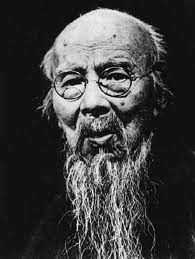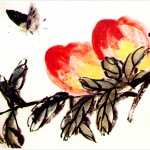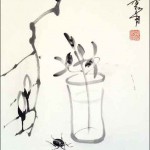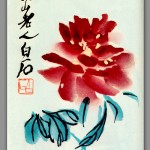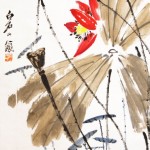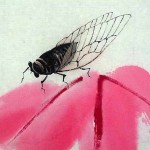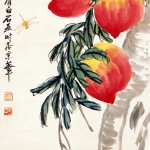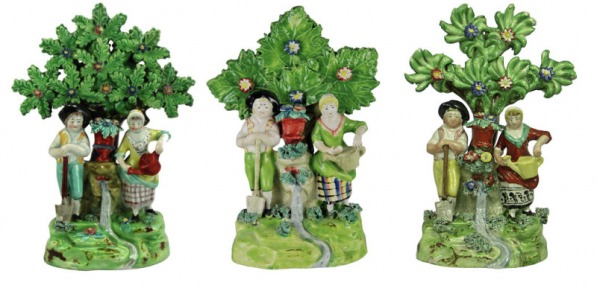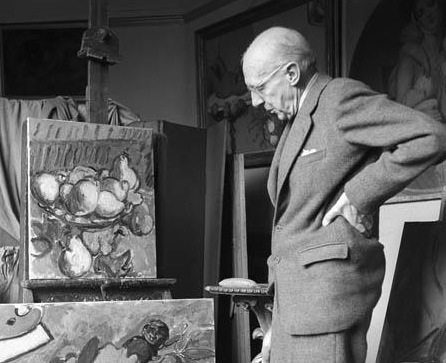Qi Baishi (Ch’i Pai Shih) is one of the greatest Chinese painters. Chinese tradition places essences, character, and spirit above the simple faithfulness to appearances. Qi Baishi’s paintings well represent the Chinese tradition, but in an innovative form and style. Though the art of Qi Baishi was originated from nature, which one can learn from his paintings of animals, insects, and flowers, he painted them in a way nobody else had achieved before. He once said, “The excellence of a painting lies in its being alike, yet unlike. Too much likeness flatters the vulgar taste; too much unlikeness deceives the world.” Qi Baishi had developed his style over his life-long learning, studying, and innovation. His paintings were not matured until his late life.
He was born in Xiangtan, Hunan Province, on Jan. 1, 1864. His birthday was in 1863 based on the Chinese lunar calendar. His family was poor like most Chinese families and they lived on the cultivation of rice on a small piece of land. At seven, he learned about 300 Chinese characters his grandfather was able to teach. He only had one year formal education when he was eight years old. The tuition for the one year was paid using his mother’s saving.
Qi Baishi’s major activities are summarized below:
- 1877: When he was sixteen, he started to learn carpentering with Zhou Zhimei, a woodcarver.
- 1881: At 19, Qi Baishi married with Chen Chunjun (1863-1940).
- 1888: Qi Baishi started to learn painting with Xiao Xianghai, who was the finest portraitist in Xiangtan. Studied calligraphy and literature under Hu Qinyuan and Chen Shaofan, respectively.
- 1899: Qi Baishi became a student of Wang Xiangyi, who was one of the most influential scholars of the time.
- 1892-1901: Joined the Dragon Hill Poetry Society and the Longshan Poetry Society.
- 1902-1909: Five trips. He was invited by Xia Wuyi to Xi’an. He toured Beilin there, where there were over 1,400 stone tablets engraved with writings by China’s finest masters of calligraphy. Later, he went to Beijing, the capital, with Xia Wuyi. He was then introduced to some big names of arts, such as the jinshi-degree scholars Zeng Xi and Li Ruiquan. Li Ruiquan tutored him in the script styles of Northern Wei dynasty steles. In 1905, Qi Baishi borrowed an album of seal impressions by Zhao Zhiqian, who had been a major pioneer of modern jinshi art. He also made a trip to Guilin in 1905. He traveled to Qinzhou with Guo Baosheng and others in 1907. They went on the trip to as far as Vietnam. Later, he traveled to Guangzhou, Hongkong, Shanghai, Suzhou, and Nanjing.
- 1917: Settled in Beijing. Qi Baishi met with Chen Shizeng. His relationship with Chen Shizeng is considered as one of major turning points of his career.
- 1919: Qi Baishi had a new concubine, Hu Baosheng from Sichuan. She was 18 years old.
- 1920: Lin Su compared Qi Baishi with Wu Changshi in his remark, “Wu in the south and Qi in the north may be considered a pair.” Lin Su was an influential artist. Wu Changshi was the greatest living exponent of the Shanghai school of painting. The dramatist Qi Rushan introduced Qi Baishi to Mei Langang (1894-1861), who was a famed opera star.
- 1922: Chen Shizeng took Qi Baishi’s paintings to an exhibition, featuring paintings by both Chinese and Japanese artists in Tokyo. All of his paintings were sold and two of his works were selected for public display in Paris.
- 1927: He started to teach traditional painting at the Beijing Art Academy, invited by the director Lin Fengmian. When the school changed its name to the Beijing Art College in 1928, Qi Baishi became a professor. He published his ‘Jieshanyinguan Shicao’, a collection of his poetry.
- 1933: Baishi Shicao, a collection of his poetry in eight volumes, was published. And he also printed a ten-volume seal album with cinnabar seal ink.
- 1937: The Sino-Japanese war broken. Japanese controlled Beijing and Tianjin. In protest, he locked his door and refused to see most guests. He posted a sign on his door, “Old Man Baishi has had a recurrence of heart sickness and has stoped receiving guests.” Qi Baishi quit teaching at the Beijing Art College.
- 1940: His wife, Chen Chunjun, passed away.
- 1941: Qi Baishi officially married Hu Baozhu.
- 1944: Hu Baozhu passed away.
- 1945: Japan surrendered. Qi Baishi resumed the sale of his paintings and seals.
- 1946: He asked Hu Shi to write his biography. He hold one-man exhibitions of his paintings in both Shanghai and Nanjing, invited by the Shanghai Art Society and the All China Art Society, respectively. He met Chiang Kai-shek and was honored in a grand and solemn ceremony. Qi Baishi accepted Zhang Daofan as his student, who was Director of the All China Art Society.
- 1949: Qi Baishi was elected a member of the National Committee of the Chinese Federation of Writers and Artists and of the National Committee of the Chinese Artists’ Association. Xu Beihong, Director of the Central Academy of Art, appointed Qi Baishi to the honorary professor.
- 1953: He was conferred the title “People’s Artist” by the Central Cultural Ministry. He became Chairman of both the Chinese Panting Research Society of Beijing and the Chinese Artists’ Association.
- 1954: Elected the Hunan province representative of the National People’s Congress.
- 1955: East Germany’s Academy of Art appointed him an honorary fellow.
- 1956: The World Peace Council granted their International Peace Award to Qi Baishi.
- 1957: Qi Baishi was named Honorary President of the Beijing Studio of Traditional Chinese Painting. And a film entitled “The Artist Qi Baishi” was made. Qi Baishi passed away on September 16, 1957.
In 2009 he was the biggest selling artist due mainly to the wealth of Chinese collectors.

